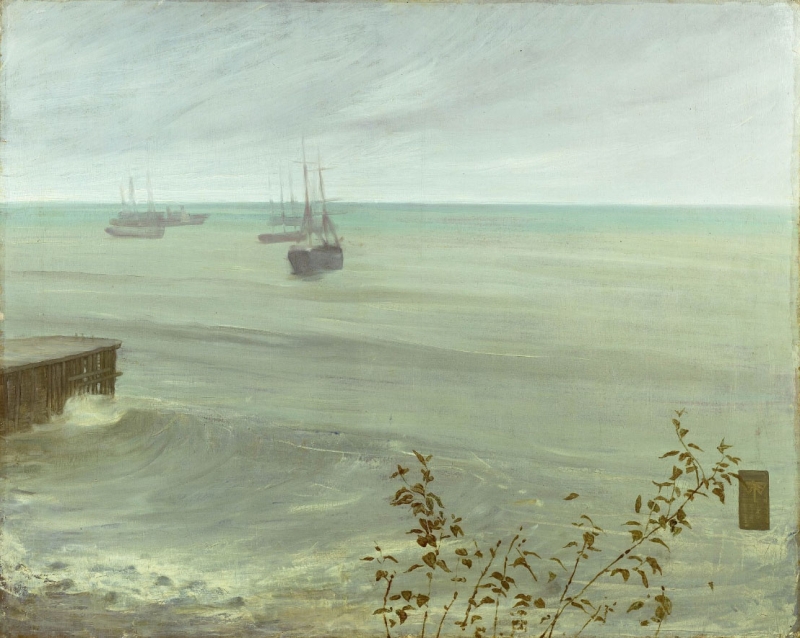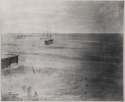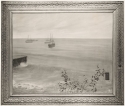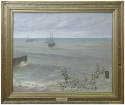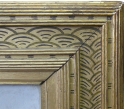Composition
An old photograph, reproduced above, shows the original composition, without the foreground foliage and the cartouche with a butterfly monogram. These were probably added for the 1872 exhibition, at which time The Times found 'the presence of the monogram and leafed twig in the foreground in Japanese fashion intrusive as well as imitative'. 1 The Frick website comments, 'the leafy branches and the cartouche that contains his butterfly monogram ... derive from Japanese woodblock prints. The wave pattern on the resurfaced frame most likely replicates Whistler’s original design.' 2
Technique
The Frick conservation records state that the painting is on 12 threads/cm coarse linen canvas, on a 5-membered pine stretcher. The Frick website describes the brushwork:
'To render the rolling waters of the Pacific, Whistler dragged his brush from one side of the canvas to the other, creating long ribbons of muted tones. The imprint of the brush’s bristles in the paint enhances the illusion of a rippling sea.' 3
From a visual examination of the painting, Professor Joyce H. Townsend notes that the canvas was painted with a mid-toned pinkish grey imprimatura made from a bright pink pigment. Although the artist used a very fluid paint medium, there are no drips, even for the most thinned area of the pier. Most of the surface was painted with long horizontal brushstrokes, with more gestural ones for the waves breaking round the pier; here the paint is less thinned, and where it is thicker it has cracked in a pattern that suggests it is not resinous or megilp-like; the added green leaves may have a megilp medium however.
There is no evidence that the number of ships has ever varied. No ships were overpainted, wiped away or left unfinished; it is likely therefore that this was genuine alla prima painting, but it could be that earlier versions were very thoroughly effaced. Professor Townsend adds:
'Examination supports the suggestion that the leaves and butterfly signature were planned together and executed at the same time.
The water, except at the pier, was painted wet-in-wet with the colours almost mixed on the canvas (using perhaps only blue, pink and black in a lot of white), in canvas-wide horizontal brushstrokes, and may include Whistler’s 'sauce'. The appearance and ageing of the paint is very reminiscent of the paint of the Tate nocturnes painted 1870-1871. The ships were applied on top, to slightly wet paint, with thinned paint that has not run – again suggesting the use of a paint medium modifier. The pier was applied over existing water, therefore the choppy waves in front of it must have been painted during the last stage of the first version.' 4
Conservation History
During preparations for his 1892 retrospective, Whistler took a strong interest in the condition and framing of his works, asking David Croal Thomson (1855-1930) to arrange with owners for the necessary repairs to be carried out by Stephen Richards (1844-1900). Richards was appalled at the condition of this painting:
'I wish to draw your attention to the state of Mrs Peter Taylor's picture, it is in a most dangerous condition, in the first place the Canvas is literally rotten and if the picture is to be preserved it must be relined or the paint will soon flake from the canvas, this could not be done before the exhibition, there are also many very nasty blemishes in the sky, the cause of which is in the painting, the canvas not being thoroughly covered consequently with time the ground on which the picture is painted becomes darker and shows up in dark patches, this is a very common occurrence, it is in a very unfit state for exhibition and by the side of others would look extremely bad, it is a great pity that such a fine picture should be allowed to get in such a state, nothing has been done to the picture since it was painted, so I am not at all surprised at it going so, it requires nourishing, I should strongly advise the owner to have the picture cleaned and the stains restored at once, then after the exhibition to let me have it lined, the picture then would be in a perfect and durable condition.' 5
However, D. C. Thomson had problems getting permission from the owner, Mrs Peter Taylor (1911-1996) . 'This lady is a great invalid', he wrote, 'She sends word that if you will add a few lines to the enclosed from Richards (which we got ready to persuade her) she will accede to all we require - Will you therefore say you approve at the end of Richards note.' 6 By 12 March, however, Thomson was reporting that Richards had it 'in hand.' 7
A comparison of the painting today with photographs of it in 1892 and 1914 shows that one of the branches of foliage added by Whistler before 1872, was removed at some time, probably after Whistler's death. In these old photographs the third branch from the right, which crossed the long branch touching the cartouche, led up to a solitary leaf at top left: now the top two or three leaves are isolated and that part of the branch has disappeared.
The Frick records show that the canvas was already lined by 1935, when William Suhr removed the varnish and applied a retouching varnish. According to the 1968 Frick catalogue, the painting was cleaned in 1945 and was in good condition. 8
Frame
1872/1874: it was originally framed in a reeded cassetta, possibly made by Foord & Dickinson, that would have had a decorated frieze and butterfly signature. The frame was probably made for the Dudley Gallery exhibition in 1872, but could have been slightly later. It is a good example of original wood, but not an original surface. The wood certainly dates from Whistler’s lifetime, and quite possibly is the first and only frame to surround the painting. Whistler did not paint the surface as seen today but the current painted decoration may be based on his design. 9
1892: on 22 February 1892 Whistler wrote to D. C. Thomson:
'The picture which is very dirty should go at once to Richards to be cleaned & varnished - Frame in very bad state I fear - Grau had better see what can be done - he might find a larger frame in my studio that would cut down to it - the old frame of Carlyle, or the one of my Mother, would do, regilded.' 10
A bill sent to Whistler from the Goupil Gallery on 20 May 1892 notes that the old frame had been 'regilt' because the owner had refused to accept a new frame. 11
The painting was definitely not shown with painted decoration at the Goupil Gallery in 1892, but it is not clear whether it was shown in the re-gilded 1870s frame or an 1892 Grau frame. The painting was sold during the exhibition to William Taylor Malleson, who apparently showed a preference for the old frame and not a new one made by Grau. Thomson wrote to Whistler on 11 April saying Malleson ‘is willing to send the Picture to Paris if it is insured against all risks & if you agree to have the old frame put in new condition afterwards.' 12 Thomson wrote again to Whistler on 23 April concerning the restoration of the original frame: ‘The present owner wants to use his old frame again & asks us to put it in hand for him (at his expense) if you will decide who is to [do] the colouring or decorating on the frame.’ 13 Whistler did not respond to Thomson’s request, or at least, no reply is recorded.
1892/1904: The present frame is silver toned, and two narrow fillets are painted with a bamboo stalk design, on either side of a broad central fillet neatly painted with a seigaha (wave) pattern, and signed with a butterfly. This was probably based on the original decoration. Thomson or Malleson or a later owner must have found a suitable person to ‘restore’ it. 14
Notes:
1: The Times, London, 11 November 1872.
2: The Frick website at https://www.frick.org.
3: Ibid.
4: Report from Professor J. H. Townsend, Tate Britain, 2018.
5: Richards to Boussod, Valadon & Cie, 9 March 1892, GUW #05188.
6: Thomson to Whistler, 11 March 1892, GUW #05702.
8: Frick 1968 [more] , vol. 1, pp. 6-9.
9: Dr Sarah L. Parkerson Day, Report on frames, 2017; see also Parkerson 2007 [more] .
10: GUW #08212. 'Carlyle' is Arrangement in Grey and Black, No. 2: Portrait of Thomas Carlyle [YMSM 137], and 'Mother' is Arrangement in Grey and Black: Portrait of the Painter's Mother [YMSM 101].
14: Parkerson 2017, op. cit.
Last updated: 13th January 2021 by Margaret

